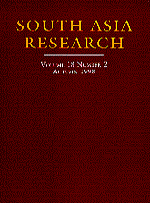South Asia Research 2010 - 30,1
Verfasst von pw am Mo, 01/25/2010 - 19:31.
South Asia Research
South Asia research / South Asia Centre, School of Oriental and African Studies, University of London. Editor: Werner Menski. - London [u.a.] : Sage Publications.
Erscheinungsverlauf: 1.1981-
ISSN 0262-7280 (Printausgabe)
ISSN 1741-3141 (Online-Ausgabe)

Homepage: Sage Publications
Zuletzt erschienen: Vol. 30,1 (February 2010)
Inhalt: 30,1 (Febr. 2010)
- Shalina Mehta: „Commodity Culture and Porous Socio-Religious Boundaries: Muslim Women in Delhi“. - In: South Asia Research. - 30,1 (Febr. 2010), S. 1-24. DOI: 10.1177/026272800903000101
Abstract: Based on fieldwork, this article portrays the deep influence exercised by modern media on the women in a Muslim neighbourhood in Delhi during the past 30 years. While visual media consumption was earlier largely tabooed and restricted, today’s consumers of media products appear significantly influenced by a media-driven com-modification of culture. The research findings indicate that a revision of ‘traditional’ assumptions about the lifestyles and thought patterns of Muslim women, at least in this particular neighbourhood in Delhi, is required to understand the current daily realities of Muslim women’s lives in South Asia.
- Charlie Henniker: „Pink Rupees or Gay Icons?: Accounting for the Camp Appropriation of Male Bollywood Stars“. - In: South Asia Research. - 30,1 (Febr. 2010), S. 25-41. DOI: 10.1177/026272800903000102
Abstract: Discussions of contemporary films and publications now illustrate the problematic terminology of terms like ‘gay’ or ‘camp’ in India, coupled with increasing speculation and reference to homosexuality. This article analyses media representations of Hindi cinema stars and highlights the emergence of some male stars as icons for gay communities within India and in the diaspora. Analysis of the way Bollywood celebrities are represented in India’s press in-dicates that the media has been crucial for this emergence to occur. Focussing on Shah Rukh Khan, Bollywood’s most recognisable and influential star today, the article argues that while a cult of interpretation surrounds Bollywood icons, there is a definite trend of stars confronting and negotiating sexually ambiguous spaces, both on screen and off. Media ‘gossip’ and specific public responses thus serve a variety of commercial as well as socio-cultural and wider political purposes.
- Mohd Sanjeer Alam: „Social Exclusion of Muslims in India and Deficient Debates about Affirmative Action: Suggestions for a new Approach“. - In: South Asia Research. - 30,1 (Febr. 2010), S. 43-65. DOI: 10.1177/026272800903000103
Abstract: Many nations today grapple with problems of social exclusion along ethno-religious lines and face demands for some kind of affirmative action by disadvantaged ethnic, racial and religious groups. In India, caste inequalities among Hindus have long been recognised and substantive measures for redressing disadvantages of lower castes have been in place for decades. Since India’s Muslims, too, are faced with various types of social exclusion, there have been ongoing debates about the necessity of state intervention in the form of affirmative action for Muslims.
The article interrogates various strands of this debate. While relative socio-economic disadvantages among Muslims cannot be denied, how Muslims are currently presented as a marginalised and excluded community is shown to be too simplistic and actually leads to isolation. In view of the multi-dimensional nature of group disadvantage for Muslims, particularly spatial patterns observable across India, more careful understanding is needed to develop effective affirmative action policies. While deeply flawed reasoning grounds prevailing current arguments in favour of separate affirmative action for Muslims, the article suggests that the aim should be to achieve better development for all disadvantaged people from all communities in any particular space.
- Werner Menski: „Slumdog Law, Colonial Tummy Aches and the Redefinition of Family Law in India“. - In: South Asia Research. - 30,1 (Febr. 2010). DOI: 10.1177/026272800903000104.
Ähnlich
- Indo tetsugaku bukkyōgaku ronshū 2014 - 2
- JICPBS 18 (2014)
- Zeitschrift für Indologie und Südasienstudien 2013 -- 30
- ARIRIAB 17 (2013) Supplement
- ARIRIAB 17 (2013)
- MSS 2013 - Heft 67,1
- Berliner Indologische Studien 21 (2013)
- Bulletin d'études indiennes 2012 - No. 30
- Bulletin d'études indiennes 2010-2011 - No. 28-29
- Acta Tibetica et Buddhica 2013 - 6
